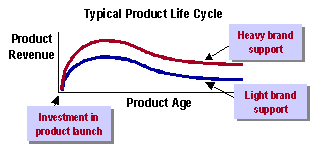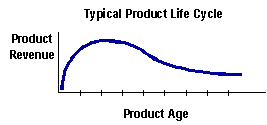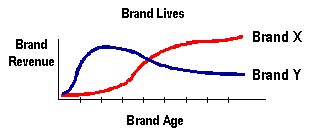Marketing and Advertising
Marketing and advertising costs are expensed in the period in which those activities occur. Some of these costs may be associated with new product introduction or brand building. The returns from these activities may materialize over a period of years. Such lagging returns may reduce accounting profit below what it otherwise would be in any year in which such activity is undertaken.
Accounting conservatism requires the expensing of all marketing and advertising, even when these activities provide benefits far beyond the accounting period in which they are expensed. This treatment reflects the intangible nature of product introductions and brand building and their lack of value as collateral to lenders.
Economics of product introductions and branding:
Gaining product acceptance and building brand value require up front expense. Once a branded product is successfully established, it allows the brand owner to command premium prices over the life the product and provides a platform for product line extensions that take advantage of brand awareness.
 Evidence shows that the stock market will support companies that incur additional
expenses to maintain a good brand for future exploitation and will
penalize the failure to support or exploit an established brand.
Evidence shows that the stock market will support companies that incur additional
expenses to maintain a good brand for future exploitation and will
penalize the failure to support or exploit an established brand.
Behavioral Impact
Expensing what should be viewed as an investment is a clear case of mis-matching costs and revenues in reporting. If management is experiencing a year of lower-than-expected profitability, one tempting target is to cut back on new product rollout spending or brand building activity. This is tempting because the foregone benefits of spending on marketing new products or enhancing brands may not be felt for several years, while the benefits of the spending cut appear dollar for dollar in the current period.


In many cases, marketing and advertising spending is budgeted as a percentage of sales. This tends to keep these expenses relatively smooth over time. While useful for maintaining an established product line, opportunities for new product introductions do not appear smoothly over time. Spending based on percentage-of-sales in the face of new product introductions will encourage over or under-spending relative to true opportunities for value-creating investment that arise.
Alternative Treatments
Capitalizing marketing and advertising: Since brand building expenditures can be viewed as investments, they can be treated as investments, that is, capitalized and amortized over the expected life of the benefits. This would better match the costs of marketing and advertising expenses with their long-term benefits.
Distinguishing between product support and product launches: Most marketing and advertising expenses are used for product support that have fairly current benefits (or penalties, if the expense is not incurred). Only expenses associated with long-term brand awareness or the introduction of new products are worth capitalizing.
Thus, spending must be segregated so that only those items with long-term benefits get capitalized.
 Estimating useful life of products:
The life of a new product can be very difficult to predict. For
simplicity and objectivity, a five year amortization period for new
products is generally adopted by companies choosing to capitalize
marketing or ad expenses. Even if management knows that the product life
may be longer, a five year amortization will usually reduce the current
impact of the expense enough to encourage an appropriate judgment on how
much should be spent.
Estimating useful life of products:
The life of a new product can be very difficult to predict. For
simplicity and objectivity, a five year amortization period for new
products is generally adopted by companies choosing to capitalize
marketing or ad expenses. Even if management knows that the product life
may be longer, a five year amortization will usually reduce the current
impact of the expense enough to encourage an appropriate judgment on how
much should be spent.
Estimating useful life of brands: The impact of advertising on the life of a brand is very difficult to
determine. Brand values depend partly on the amount of advertising
support they get, but mostly on product performance.
Also, brand values rise with ad spending in a non-linear relationship. At some level of spending we reach accelerating returns while at others we reach diminishing returns. These points are difficult to predict since they depend on market psychology that can be impossible to quantify or on timing of exogenous factors that are impossible to predict.
The value of brands acquired through acquisition of a company would be reflected in goodwill This value should be isolated and amortized on a basis consistent with any amortization of purchased, leased, or internally created brands.